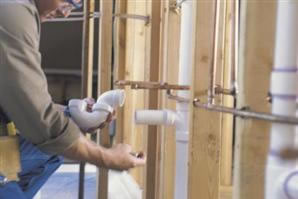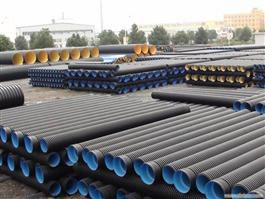An electrical conduit is a tube used to protect and route electrical wiring in a building or nonbuilding structure. Electrical conduit may be made of metal, plastic, fiber, or fired clay. Most conduit is rigid, but flexible conduit is used for some purposes.
Conduit is generally installed by electricians at the site of installation of electrical equipment. Its use, form, and installation details are often specified by wiring regulations, such as the US National Electrical Code (NEC) and otherbuilding codes.
Electrical Conduit and Fittings can help with your VAC Equipment, Machine Tools, Marine Equipment, Motors & Controls, Printing Equipment, Pumps, Refrigeration Equipment, Transformer Connections, Outdoor Lighting, Automotive Equipment, Computer & Peripherals, Fiber Optics, Lab Equipment, Lasers, Office Equipment, Robotics and more.
Flexible, Nonmetallic Electrical Tubing is available in 1/4" thru 2" trade size. Resists corrosion, oil, and water. Its maximum flexibility allows it to be used in extremely tight quarters. It resists abuse, pull and crushing. The smooth inside for easier wire pulling. Light weight. Outdoor and sunlight resistant. Quick installation, cuts with utility knife or PVC cutter. Integral rigid & flexible PVC construction. Suitable for use in high vibration or flexing applications. Ideal for fiber optic cable protection.
PREFERENCES
They are very light, which makes it easier to assemble and transport them.
• Their smooth internal surface makes I t easy to insert the cables inside the pipes
• They have excellent mechanical and physical features
• They are resistant to impact, as well as impermeable to water and dust
• They are long lasting, and without need for maintenance
• flexible pipes make possible continuous placing and are very adaptable to the demands of the terrain; also these pipes are very cost saving.
• they are used at temperature range from -40°C up to +80°C
• they are highly resistant to corrosion
• Light material, easy and quickly to storage and manipulate
• Easy to transport, simple and cheap assembling process
• The process of connecting two PVC pipes doesn’t last for more than 1 minute, there for the interruptions of the traffic do not last very long
• They have thin walls, so that the laying of the cables inside the pipes is very swift and simple
• In the same trench a large number of pipes can be laid next and on top of each other
• Connections are impermeable to water and any other fluids
• They are resistant to corrosion in alkaline, acid or any other aggressive environment
• They are fine electrical insulators and also resistant to stray currents
• They’re resistant to impact
• They are resistant to ageing (with the life time of more than 50 years)
Electric PVC Corrugated Pipe Outdoor advantages:
1, light, transportation and handling facilities:
PVC pipe is very light material, handling, loading and unloading, construction convenient, can save labor.
2, PVC pipe excellent chemical resistance:
PVC pipe has excellent acid, alkali, corrosion resistance, the use of the chemical industry for the very fit.
3, PVC pipe fluid resistance:
Smooth wall PVC pipe, the resistance of the fluid, the roughness coefficient is only 0.009, lower than the other pipe, in the same flow, the diameter can be reduced.
4, PVC pipe mechanical strength:
PVC pipe pressure resistance strength, resistance to external pressure strength, impact resistance, strength very good conditions for all kinds of piping works.
5, PVC pipe for electrical insulation:
PVC pipe full of excellent electrical insulation for wire and cable conduits, wires and pipes of buildings.
6, PVC pipe does not affect the water quality:
PVC pipe is not affected by the dissolution tests confirmed the water quality, water piping for the present the best pipe.
7, simple construction:
Construction PVC pipe joints quickly and easily, so the construction project cost low.
They are used for power and PTT installations in industrial and construction building. They are placed in the mortar and in concrete layer. Cables can be inserted quickly and easily inside the pipes, even on curved surface.Because of its bending ability, they are practical for air conditioning of the halls, workshops, restaurants and other premises。
Conduit may be installed underground between buildings, structures, or devices to allow installation of power and communication cables. An assembly of these conduits, often called a duct bank, may either be directly buried in earth, or encased in concrete (sometimes with reinforcing rebar to aid against shear forces). Alternatively, a duct bank may be installed in a utility tunnel. A duct bank will allow replacement of damaged cables between buildings or additional power and communications circuits to be added, without the expense of re-excavation of a trench. While metal conduit is occasionally used for burial, usuallyPVC, polyethylene or polystyrene plastics are now used due to lower cost, easier installation, and better resistance to corrosion.
Formerly, compressed asbestos fiber mixed with cement (such as transite) was used for some underground installations. Telephone and communications circuits were typically installed in fired-clay conduit.
Underground Cable protection Conduits, optical cable conduits When constructing ground-buried optical cable and communication cable systems, the best solution in ensuring a long-term protection of the cables is rigid plastic conduits. The conduits can be buried directly in the soil, in concrete, or through water barriers, in concrete pipes, channels and blocks, along bridges and flyovers. The conduits are used for the installation of optical fibre cables employing traditional installation methods - pulling with a cord or blowing. Functionality of the conduits: • Quicker, more convenient, and more cost-effective construction of cable networks and preparation for cable-pulling (with cord or blowing) • Long-term protection of installed cables • Quick cable replacement without additional earthwork Advantages from the use of the conduits: • High strength • Easy coupling of conduits by means of couplers • The length-marks on the conduits allow to determine the length of the installation • High outer and inner pressure-resistance • Thermal resistance (from -25ºC to +90ºC) • The materials used ensure that the conduits are environment-friendly and feature a long-term resistance against the effects of the aggressive substances present in the soil.
Comparison with other wiring methods
Electrical conduit provides very good protection to enclosed conductors from impact, moisture, and chemical vapors. Varying numbers, sizes, and types of conductors can be pulled into a conduit, which simplifies design and construction compared to multiple runs of cables or the expense of customized composite cable. Wiring systems in buildings may be subject to frequent alterations. Frequent wiring changes are made simpler and safer through the use of electrical conduit, as existing conductors can be withdrawn and new conductors installed, with little disruption along the path of the conduit.
A conduit system can be made waterproof or submersible. Metal conduit can be used to shield sensitive circuits fromelectromagnetic interference, and also can prevent emission of such interference from enclosed power cables.
When installed with proper sealing fittings, a conduit will not permit the flow of flammable gases and vapors, which provides protection from fire and explosion hazard in areas handling volatile substances.
Some types of conduit are approved for direct encasement in concrete. This is commonly used in commercial buildings to allow electrical and communication outlets to be installed in the middle of large open areas. For example, retail display casesand open-office areas use floor-mounted conduit boxes to connect power and communications cables.
Both metal and plastic conduit can be bent at the job site to allow a neat installation without excessive numbers of manufactured fittings. This is particularly advantageous when following irregular or curved building profiles. Special equipment is used to bend the conduit without kinking or denting it.
The cost of conduit installation is higher than other wiring methods due to the cost of materials and labor. In applications such as residential construction, the high degree of physical damage protection may not be not required, so the expense of conduit is not warranted. Conductors installed within conduit cannot dissipate heat as readily as those installed in open wiring, so the current capacity of each conductor must be reduced (derated) if many are installed in one conduit. It is impractical, and prohibited by wiring regulations, to have more than 360 degrees of total bends in a run of conduit, so special outlet fittings must be provided to allow conductors to be installed without damage in such runs.
Some types of metal conduit may also serve as a useful bonding conductor for grounding (earthing), but wiring regulations may also dictate workmanship standards or supplemental means of grounding for certain types. While metal conduit may sometimes be used as a grounding conductor, the circuit length is limited. For example, a long run of conduit as grounding conductor may have too high an electrical resistance, and not allow proper operation of overcurrent devices on a fault.
Types
Conduit systems are classified by the wall thickness, mechanical stiffness, and material used to make the tubing. Materials may be chosen for mechanical protection, corrosion resistance, and overall cost of the installation (labor plus material cost). Wiring regulations for electrical equipment in hazardous areas may require particular types of conduit to be used to provide an approved installation.
PVC corrugated pipe for Electrical conduit
Corrugated halogen –free conduits for electrical installations
Plastic conduits for electrical installations
PVC corrugated pipe for Auto Wire / Electric Thread- Passing Pipes
protective pipes of lamps and lanterns wire
tubes of air conditioner and washing machine

